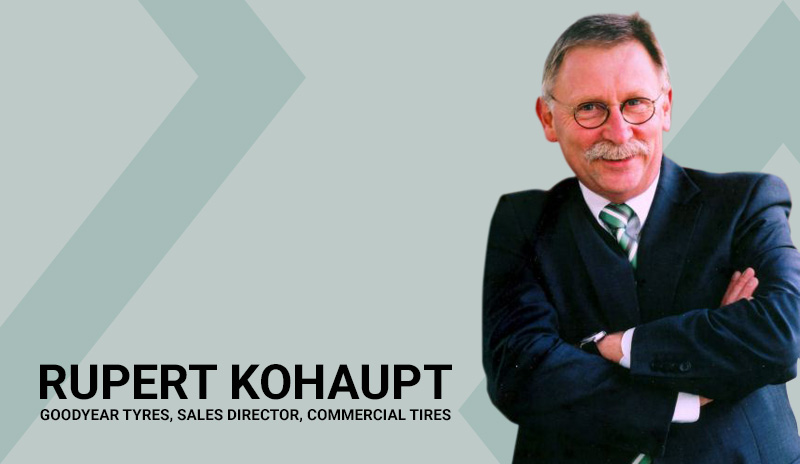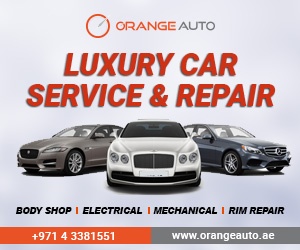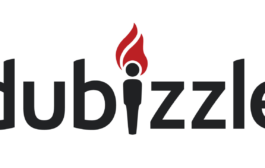Can you please tell us a little bit about yourself and how you came to be a part of the tire industry?
I wanted to go into motorsports and that is how I entered the tire industry. Bike racing is my hobby. I have been in the tire business for roughly 40 years and I have taken up different roles over the years. I am a mechanical engineer by training. I started out in truck tire development and then moved on to other functions. I was dealing with global OTR for some years and now for about the past seven years, I am leading the truck sales function for the emerging markets.
Goodyear is an established brand in the Middle East. What strategies will you be pursuing to further increase the market share?
One of our key focus areas is product performance and that is why we recently launched the new range of KMax tires. We will surely gain market share. The other one is our team. We are investing heavily in people to increase our footprint in the market. The third one is about services. It is not only about tires. You have to have the best products in the market, but especially on the commercial side, customers are expecting service. That has to be organized, you need IT solutions for that, central invoicing for bigger fleets for example, how to follow up tire performance, to get a better feeling about tire cost, which is what you as a fleet invest in tires…all these factors make your business more transparent. So, essentially we will focus on product, people and service
The past year has been very challenging for the tire industry with a high level of volatility when it comes to the prices of raw materials. How has this affected Goodyear?
Of course, it has had an impact on us and it was a given that we had to execute price increases. It also had an impact on our customers. So, the demand was not on a level where it normally is, when you look at countries like Saudi Arabia. On one side, we saw a strong requirement for pricing. As customers had to lower their costs, they were looking for cheaper products. On the other hand, lower prices as they had to lower their costs. On the other hand we saw that the bigger and professional operating fleets, they asked for reduction in the cost of ownership. That is the other side of the story. They are not looking at just the purchase price of the tires. That is not the whole story. They ask for reduced cost of ownership. That is a strong requirement.
In the truck tire segment, how is your mileage warranty and year warranty versus other brands? How would you benchmark Goodyear when compared to other brands?
These type of businesses where you have a mileage contract with a guaranteed cost per kilometre have a relatively small share of the total market, represent less than 5 per cent. That is one aspect. The other aspect is, it is very important that if you want to survive in this business, that you have to know the performance of your products. That means all our truck tire specialists (TTS), have to be very knowledgeable about product performance, both our own product performance and the performance of the products of our competitors. That is very important and is the foundation for this type of business. We invest a lot, also from the IT perspective, for fleet online solutions. We have millions of tires in a database in order to give our customers more transparency about what our mileage is in different applications. Hence, product knowledge is very important.
How important is the commercial tire market in the region for Goodyear in relation to other markets in the world? Which brands do you consider as your main competitors in this market?
At Goodyear, wherever we operate, we always focus on consumer and commercial, with commercial also including OTR and that is our general approach. There is not even one market where we sell only consumer or only truck tires. So, we always fight on both leagues. Each and every market is playing on three levels—-we have a tier 1, tier 2 and tier 3. In some markets, you also have a tier 4 which is the low end of performance. Tier 1, 2 and 3 are products which signify certain cost levels and for certain performance levels. Goodyear has four brands, which are Goodyear, Sava, Fulda and Kelly and that is our brand mix for truck tires. These four brands, you will find them at all the three levels. So, that means that we are not excluding any competitor. We are competing intensely on all fronts with all competitors. We take all our competitors seriously and there is no competitor that we consider to be more serious than others. There are some very low-end leagues where we are not competing because we have certain internal targets in terms of performance and we are not ready to play in that league. In 1, 2 and 3, we are clearly available.
Coming to direct competition, whatever you find in the market is our competitor. When we are faced with any competition, we have our database and we are competing with them in terms of performance. Normally our focus is on cost of ownership, cost per kilometre, not price per kilo.
Given the extreme weather conditions in the Middle East and the terrain here, which tires from the Goodyear range are the most suitable for use in the UAE?
When we see the UAE market, the UAE market can be divided into two segments – we have an on-road segment and we have an off-road segment or mixed service segment. The onroad segment stands for 60 per cent of the market volume and the mixed service segment accounts for another 30 per cent. These two segments account for 90 per cent of the market and then we have some niche segments like city bus and other applications. This is specifically in the emerging markets. When you look at Europe, it is a bit different. You have the winter tire business and you have the city bus applications which are bigger there but here this is the scenario. When it comes to the onroad segment, you can divide into a more regional type of application or more long distance application. That is what we had as the product launch today. We launched the long-distance tire for hot countries, like Saudi Arabia, KMax Extreme. We have another tire, the KMax Endurance, which is more the regional type of application.
Can you tell us a little more about this latest range of truck tires, KMAX Extreme?
The K stands for kilometers. We really want to be the best in class, whatever be the competition, when it comes to mileage and cost per kilometre. So, this is what KMax stands for and Extreme is because of the extreme heat conditions that those tires will have to tolerate, especially in long haul applications. The Kmax Extreme tires are designed to provide the best mileage when used on long haul highways, very hot running climate, high speeds and under the load conditions which are typical for those kind of trucks. So, they are not heavily loaded on the front axle and the tires because of the ambient temperature are also running at a rather high pressure. Due to these reasons, you need to have tires with a specific design which can provides the best footprint under these conditions to have very balanced and uniform wear. And in addition to these benefits, it comprises a rubber compound, that does not by itself generate much internal heat.
The tire is getting enough heat from the road, from the sun outside, the engine of the truck itself and you do not want that the rubber itself to generate much heat to add to the external heat. So, the tire is a low running resistance tire and generates minimal heat and this also has a side benefit as there is lower fuel consumption because the tire that is not losing energy while running reduces the fuel consumption of the vehicle.
What are the most popular sizes of the Goodyear tires in the Middle East market?
In the Middle East market, other than in Saudi Arabia, the most important size is the 24 inch tire. When you look at Saudi Arabia it is 315/80 R22.5 and 385/60 R22.5 for trailers. That is more the European sizes and the 24 inch is classic for the Middle East and partly Africa. Compared to Europe, the market is relatively transparent. There are not too many sizes. In future, we see scope for more sizes but for the time being, these are the most popular sizes.
You are the commercial vehicle tyre sales director for emerging markets. In your current role, you oversee several different regions that are growing at a fast pace. What are the distinctive characteristics of each market and how are they different from each other?
For the time being, we are seeing it as three areas. One is Turkey, the other ones are Middle East and Africa. Turkey is a market which has relatively high temperatures but they also have a strong winter. So, in Turkey, you need some comprimises. You have to have a product which is performing in hot summer over long distances as they also travel into Europe and at the same time you need good winter performance. When you look at the Middle East, we know winter is not a requirement here. Here it is about temperatures and on long distance roads, and your goal is with ability to handle high loads, high temperatures with relatively high speed. When it comes to Africa, you still have a high percentage of unpaved roads in Africa. Even long distance roads are not in the best shape. There, it is more about robustness. Temperatures are not so critical. You need a very robust product which we launched today, the KMax Endurance and that is ideal for the African market.
The standards with regard to the sale of tires have become more stringent over the years, especially in Saudi Arabia and the UAE. What impact has this had on Goodyear’s strategy in the region?
The labelling standards, SISO and GISO is new here but it is not new in Europe. We develop all our products for Europe, Middle East and Africa at our Innovation Centre in Luxembourg, we already have a lot of experience in developing tires which are excellent regarding labels and at the same time which are meeting all the requirements with regard to fleet needs – traction, mileage and so on. So, when countries in the Middle East started implementing the labelling regulations. So, when the labelling regulations came into effect in the Gulf countries, we already had a head start and we also had the technology to be the best in class in those products. The KMax Extreme that we launched today is beating competition in running resistance, as the label will indicate and also when it comes to grip. For example, a drive tire that is better than any competitor when it comes to braking on slippery roads. So, we really have an edge there. Basically, our tires comply with all local regulations, with regards to GISO and SISO with regard to rolling resistance and also they comply with safety requirements in GCC markets. Other markets in Middle East and Africa, they require E mark or DOT and our tires are compliant with these norms. When it comes to the new generation tires that we are launching today, it is indeed the best in class when it comes to labelling. We are actually one grade better than our main competitors. In terms of fuel savings, these tires can help you cut your annual fuel costs by 3 per cent, which is a lot for the fleets. That is a differentiator in addition to the cost per kilometre. In fact, we appreciate labelling because it is more transparent and makes communication easier and if you are good in labelling, it is easy to prove your claims. The main differentiator is the cost per kilometre, the mileage that beats the competition.
Customers are now becoming increasingly conscious about emissions and the fuel efficiency of the tires they use. How do you ensure that your products are as eco-friendly as possible? What are the initiatives you have taken when it comes to sustainability?
That takes us back to labelling. Rolling resistance is the main player in that. The other thing is mileage, retreadibility. It is not just what we put in the tire, but also how we produce them that makes a difference. We have a number of initiatives in all our production plants to save energy, to save heat. We actually got a major award from the German government for the energy savings initiatives that we implemented at our German plants. When it comes to sustainability, we have an end to end approach and for us, retreading the casings is also a key element of sustainability. We are a company that provides top notch retreaded products. We also have the best quality checks for the production of new tires as well and that contributes to sustainability as well.
What are the marketing partnerships you have in the Middle East market?
We are strongly collaborating with our distributors when it comes to marketing. That means we have a centralized marketing organization located in Dubai and then we communicate with the country based teams to cooperate and execute marketing plans with our distributors. That is very close cooperation and it goes both ways
How important are fleet sales and what strategies have you taken up to increase your appeal to this segment?
For us at Goodyear Middle East, all our efforts are focused on the fleet business. It is the most important business we have. We use a pull and not a push strategy. We focus on the demands that fleet customers come and if they are satisfied with the performance of the Goodyear tires that they use, they will ask for Goodyear tires again. This is what I mean by a pull strategy.
What are the major challenges that the tire industry is facing, both globally and in the Middle East?
Distribution is an important point for us as a tire company, whether we are talking about Europe, Middle East or Africa. Product availability in this environment is very important. The other point, that we discussed before, the environment is also important, about whether the tire delivers when it comes to saving energy, saving costs. When it comes to specific challenges related to the commercial tire business, as the truck architecture and engines evolve, and here I refer particularly to electric trucks, the change might come faster and might be bigger than we think and this might call for some very specific requirements for the tires that are used for such trucks. The engine torque might be different and those trucks might like to speak to the tires as well, so there might be more need for exchange of information between the tire and the truck. We might think about autonomous trucks as well. There might be big challenges coming from this as well. We are still at the beginning stage and we have not measured how big these changes are going to be.
Who are your distribution partners in this region? What factors affect the distribution and sales of your products here?
For the Middle East, region, we are handling 50 countries from the Dubai office. To guarantee that the product is available in all these places, that is where we are strongly focusing.
If there is one thing you would like to convey to readers of Tires & Parts, what would that be?
We should focus more on the environment. We spoke about retreading. Retreading is not very popular in the Middle East. It is different in Africa. In Africa, Goodyear owns more than 10 factories which produce retreaded tires. That is not the case here. There is focus missing. We could use the casings for longer than we actually do. That requires more maintenance from fleet customers, they should not wear the tire totally down such that you can’t retread any more. We need to focus more on fuel efficiency than we have now. For the past several years, there has been emphasis on fuel efficiency but it is by far not even for example, like we see in Europe. We could sum it all up by saying “environment”.















